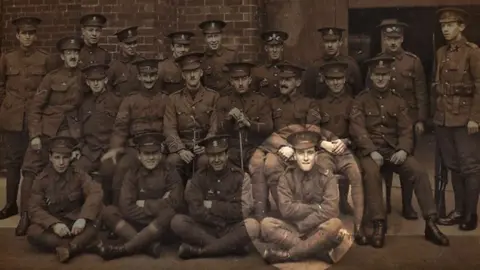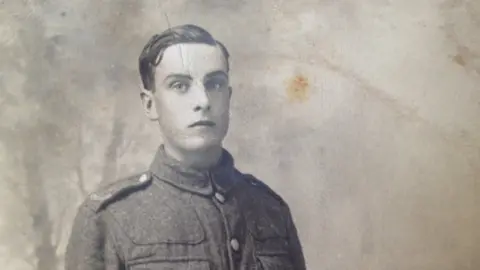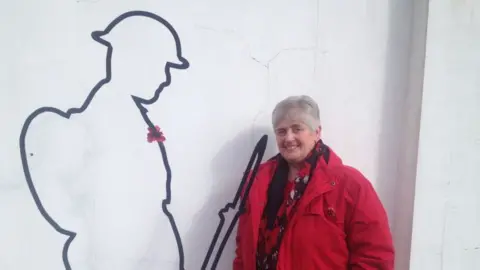Who are the World War One soldiers in Phillipstown photo?
 Phillipstown Memories
Phillipstown MemoriesWhistling a tune he had heard his German captors sing, the Welsh soldier boldly strolled out of the gates of the prisoner of war camp he had been held in for 15 months during the shift change of the guards.
World War One soldier Robert Phillips had been watching the shift pattern of the guards for months before he made his daring move.
As he walked out, the soldier of the First Battalion of the Welsh Regiment had no idea of the journey that lay ahead of him as he tried to get home.
But after four months on a lonely expedition fraught with danger over enemy lines, the ex-miner finally returned to his home, landing in Cardiff on Christmas Day.
Now more than a 100 years after his audacious adventure, his granddaughter is appealing for help to identify the names of Pte Phillips' comrades from his home town.
A picture of the the 21-strong regiment was taken in Phillipstown, New Tredegar, Caerphilly county, in 1914, before the men went to war.
Pte Phillips' granddaughter, Lynda Osborne, 67, from Hengoed, is now trying to find out more about the others in the picture.
She said: "This photo has recently been unearthed by the Phillipstown Memories Association, a community group which collects old memorabilia from the area.
"On the back, someone has written 'the unknown soldiers of Phillipstown', but it shouldn't be like that, they should be known."
"I'm hoping local people will look through old photos of their WWI veterans and help put names to these faces.
"My grandfather's story was so amazing. Hopefully, we can find out more about these men and the sacrifices they made."
The story of Ms Osborne's grandfather's escape from a prisoner of war camp after 15 months of brutal treatment is one of daring and bravery.
A miner by trade, Pte Phillips, from Blaina, Blaenau Gwent, was working in a winding house in New Tredegar when war broke out.
After signing up to the First Battalion of the Welsh Regiment in 1914, he was sent to war, fighting in the Second Battle of Ypres in April 1915.
 Lynda Osborne
Lynda OsborneStrategically important on Belgium's frontline, the town saw the first mass use of poison gas by the Germans on the Western Front.
Incredibly, Pte Phillips managed to survive by holding a wet handkerchief to his face - but some 59,000 of his comrades died.
But a few months later, fighting in Vermelles in northern France, he was taken prisoner by the Germans and sent to a camp in Homburg in West Germany.
He was held there for 15 months, alongside hundreds of other men who had been captured.
In letters unearthed by his granddaughter, he described the hellish conditions, including being "regularly beaten" by guards and forced to work gruelling shifts.
He wrote: "We had the worst treatment from wounded German soldiers who were unfit for military service.
"About a dozen of them would get onto one man, take him to a disused part of the pit and knock him about with their picks and kick him.
"On the whole I had a miserable time. No justice, one long weary record of brutal ill-treatment for 15 months."
Not wanting to cut coal for the Germans, Pte Phillips told guards he was a musician, but was overheard talking about mining and forced to work.
 Lynda Osborne
Lynda OsborneFood was scarce, often shared by 10 men and eventually, he decided to escape.
After spending months closely watching the routines of the guards, he made his move during a shift change, walking past the sentries while whistling German tunes he had learnt.
Relying on the simple survival skills taught to him by the Army, he travelled by night, navigating northward by the stars and staying off the roads in the hope he could get to Holland where he might get help from families who hated the Germans.
In an account recorded in the South Wales Daily News, he said: "I travelled as far as I could and I got into difficulties once by taking the wrong direction. I found I was walking up a private drive and I hurriedly retraced my footsteps, passing several Germans on the way."
Pte Phillips continued his 200-mile journey and eventually found himself approaching the frontier.
He wrote: "Ahead of me I could see a German soldier patrolling and, with my heart in my mouth, I crawled on my stomach within 10 yards of the soldier and over the border."
Ms Osborne believes Pte Phillips was helped by a family in Holland who took him in and either returned him to British forces or arranged for passage back to England smuggled aboard a ship.
After four months of travelling, covered with fleas and suffering from trench foot, Pte Phillips landed in Cardiff on Christmas Day 1916, describing it as the happiest day of his life.
Once back in New Tredegar, he found his landlady had sold his motorbike and clothes, but 1,000 people turned out to see him at a ceremony.

He was presented with a gold watch by local dignitaries with an inscription that read: "Presented to Private Robert Phillips by the inhabitants of New Tredegar & district to commemorate his wonderful daring and resource in escaping from Germany."
After spending time in hospital for shell shock - what is now known as Post Traumatic Stress Disorder - and damage to his lungs from poison gas, he was discharged from the Army.
He then married and had one son, Glyndwr, and returned to the mine, but in a tragic end was killed in Bedwas Pit, age 40, when the roof collapsed.
A colleague apparently tried to warn him, but he had a stammer and could not get the words out in time.
Ms Osborne said: "This is the amazing story of just one man, here's hoping that more stories about the other men now come forward."
Anyone with information about the men in the photo is asked to contact the Phillipstown Memories Association.
